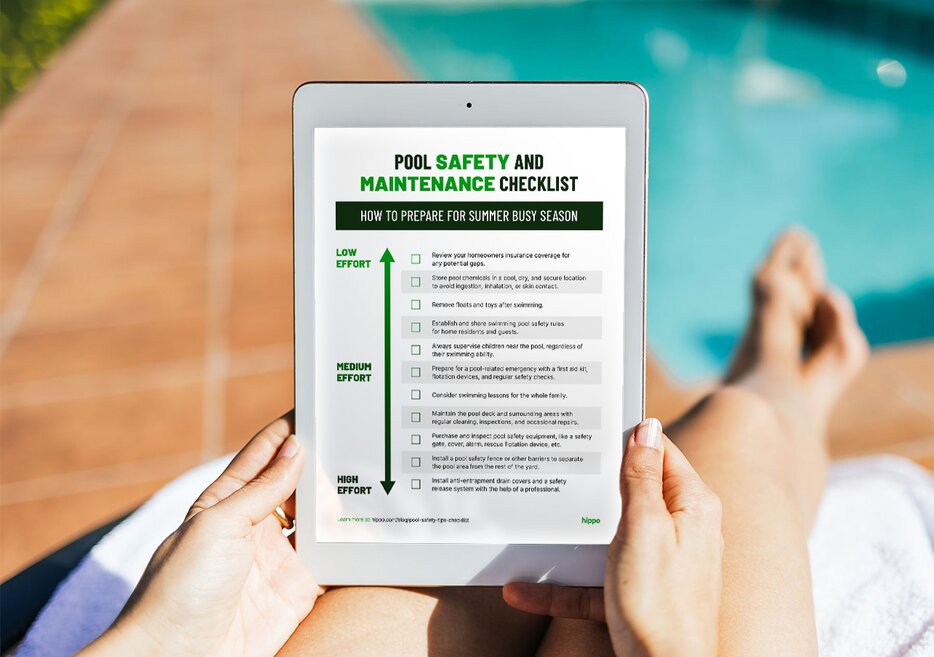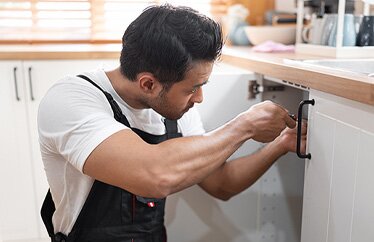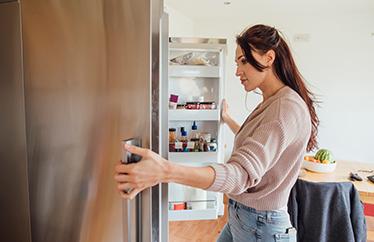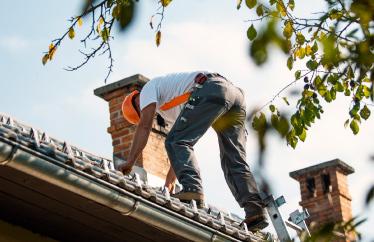11 Pool Safety Tips for a Worry-Free Summer [Free Checklist]

Summer is here, and that means pool season is in full swing. And while it might be tempting to take a vacation from preventative maintenance, it’s actually essential to a more enjoyable (and less stressful) season. This is especially true if you own a pool, which requires year-round maintenance.
Fortunately, many U.S. homeowners are off to a great start. Our Pre-Summer Check-In Survey found that nearly half of responding homeowners (48%) prioritize seasonal maintenance tasks. This is an excellent attitude to have if summer safety is top-of-mind in your household.
To help you prepare your home for safe, poolside fun, we put together these 11 easy-to-follow tips and a handy downloadable checklist.
1. Review your homeowners insurance coverage
- Review your current homeowners insurance policy documents to see what pool liabilities it covers. This can depend on factors like your pool size, type (above-ground or in-ground), and any safety features you have installed around your pool, like self-latching gates, pool alarms, safety covers, etc.
- Depending on your pool and risk tolerance, you can explore additional coverage options. These could include increased liability limits or specific pool equipment coverage.
- Once you've decided on the appropriate coverage for your pool, ensure all changes are documented and reflected in your policy. Remember to actively maintain your pool (and its safety features) to help reduce the likelihood of accidents and support peace of mind.
2. Maintain the pool deck and surrounding areas
- Sweep or hose down your deck regularly to remove leaves, dirt, and debris. Clean up spills of food, drinks, or pool chemicals immediately to prevent staining and deterioration of your deck surface. Deep clean your deck at least once a season using a deck cleaner appropriate for your deck material (wood, concrete, etc.).
- Regularly inspect your deck for loose boards, cracks, or uneven surfaces. Repair minor issues promptly to prevent further damage and potential safety hazards.
- Clean and store pool furniture regularly to prevent mildew growth and rust. Consider using weatherproof furniture covers during off-seasons.
- Apply sealant to your deck periodically (following the manufacturer's recommendations) to protect it from moisture and harsh weather conditions.
- Trim surrounding vegetation to prevent leaves and debris from accumulating on your deck.
3. Purchase and regularly inspect pool safety equipment

- Familiarize yourself with pool safety codes to ensure you're buying reliable equipment. Research different product options based on your pool's size, needs, and budget.
- Consider hiring a licensed pool professional to properly install complex equipment like fences, self-latching gates, or alarms.
- Don't wait for problems to arise. Have a qualified pool professional inspect your safety equipment at least annually or more often if there's heavy use or any concerns.
- Follow the manufacturer's recommendations for cleaning and maintaining your pool safety equipment. This includes regularly testing alarms and inspecting pool covers.
4. Add and maintain anti-entrapment drain covers and a safety release system
- Anti-entrapment drain covers typically screw or snap into place over the existing drain. First, identify your pool drain type (main drain, skimmer drain, etc.) to ensure you purchase the correct cover design.
- To install the anti-entrapment drain covers, follow the manufacturer's instructions for your specific cover model and drain type. In many cases, this should be a manageable DIY task.
- Safety release systems involve plumbing modifications to your pool equipment. They may require cutting pipes, installing new valves, and connecting to the pool's electrical system.
- Given the potential for compromising your pool's filtration system or creating electrical hazards, consider hiring a licensed plumber or pool technician familiar with these systems for proper installation.
5. Install and regularly service a pool safety fence or other barriers
- Contact several installers to request quotes for your pool safety fence project. During consultations, ask detailed questions about their experience, qualifications, and warranty on their work.
- After the installation, do a walk-through to ensure everything meets your expectations and complies with local codes. Ask the installer any questions you may have about the fence’s operation and maintenance.
- Conduct thorough, monthly inspections and preventative maintenance for the fence—especially during the pool season.
- Tighten loose screws, bolts, or brackets on the fence posts, panels, and gate.
- Inspect the fence panels, posts, and gate for any cracks, tears, warping, or rust (in the case of metal fences).
- Ensure the self-latching mechanism on the gate functions smoothly and securely. Replace any worn or malfunctioning parts.
- Verify there are no gaps under the fence or near the gate posts that a small child could squeeze through.
- Clean your fence a few times a year or more often if it’s heavily exposed to dirt, dust, or pool chemicals.
6. Establish swimming pool safety rules
Effort required: Low to medium (requires active attention)
Think of pool rules as your home’s personal poolside playbook. They establish clear expectations for everyone using the pool, reducing confusion and helping reduce the likelihood of accidents. Consider establishing the following boundaries to help you create a safe and enjoyable environment.
Steps to take:
- Walk around the pool area and discuss potential risks with your family, like slippery surfaces or diving boards.
- Encourage children and other pool users to participate in creating the rules, fostering a sense of ownership and responsibility.
- Tailor rules to different age groups. Younger children might need stricter supervision or limitations on unsupervised pool time. Remember to revisit your rules periodically.
- Clearly display pool rules in a prominent location for easy reference. This helps family members and guests understand the rules before entering the pool.
- When it comes to children using the pool, focus on rewarding safe behavior instead of just punishing rule-breaking.

7. Store pool chemicals in a secure location
- Choose the right location. This should be a cool, dry, well-ventilated area away from direct sunlight and heat sources. Consider a locked cabinet in a garage or basement if these areas are not prone to moisture.
- Clearly label the containers to easily identify the contents without opening them. Stick to the original packaging with tight-fitting lids or caps to help prevent spills and leaks.
- Always wear protective equipment when handling pool chemicals, and avoid storing incompatible chemicals next to each other. For example, acids and chlorine products can have a dangerous reaction when mixed.
- Keep a fire extinguisher with a rating suitable for chemical fires (Class ABC). Place the extinguisher near the chemical storage area but not directly inside it.
- Post the Poison Control Center phone number in a visible location in case of accidental chemical ingestion. It’s also important to have a chemical spill kit readily available, including absorbent materials, gloves, goggles, and a dustpan for cleanup.
8. Remove floats and toys after swimming
- Make cleaning up pool toys and floats an official pool rule. Set up a designated storage area for pool floats and toys, such as a poolside shed, rack, or basket.
- Before storing floats or toys, give them a good wipe-down and make sure they’re dry before storing them. This can help prevent mold or mildew.
- Encourage everyone who uses the pool to participate in putting away floats and toys after swimming time. For younger children, consider offering small rewards or incentives for helping put away pool toys.
9. Always supervise children near the pool
Effort required: Low to medium (requires active attention)
When it comes to time by the pool, no one wants to imagine the worst-case scenario. But, according to the National Drowning Prevention Alliance, drowning is the number one cause of injury-related death for children between one and five years old and the second leading cause of injury-related death for kids ages one through 14.
Drowning can happen quickly and quietly. That’s why constant supervision is essential for all pool-owning homeowners—regardless of a child’s swimming ability.
Steps to take:
- Assign a responsible adult to be the designated pool supervisor. If you have multiple adults present, rotate this role to ensure everyone can relax while still maintaining supervision.
- Set up chairs or designated areas near the pool to give supervising adults a clear view and quicker response time. Don't rely on pool toys as substitutes for constant adult supervision.
- Schedule breaks for both children and adults. Young children can tire quickly, so plan for frequent breaks out of the pool and ensure adults don't get fatigued from constant supervision.
- Knowing CPR can make a lifesaving difference in the crucial moments of a pool emergency (or even beyond the backyard). Consider enrolling in a CPR certification course to be prepared.
10. Consider swimming lessons for the whole family
Effort required: Varies (depends on age and prior experience)
Having a pool is equal parts fun and responsibility. While swimming pool safety rules and constant supervision are crucial, consider taking swimming lessons as an added layer of protection in and out of your home environment.
In an unexpected situation, skills like proper breathing techniques, how to calmly stay afloat, and basic strokes can help make a difference in a potentially dangerous situation.
Steps to take:
- We don’t recommend DIY-ing this pool safety tip unless someone in your household is a certified professional. Explore certified providers in your area through local pools, community centers, private instructors, or group classes.
- Look for programs specifically designed for different age groups. Young children might benefit from playful, water-acclimation classes, while older children and adults can focus on mastering strokes and building confidence in deeper water.
- Ask potential instructors about their safety protocols and emergency response procedures. Ensure they have proper certifications and lifeguarding experience.
- Have an honest conversation with your family about the importance of learning to swim. This is also a great time to get everyone excited about learning new skills and spending quality time together.
11. Be prepared for a pool-related emergency
Effort required: Low to medium
While accidents are hopefully rare, being proactive and prepared for pool-related emergencies is essential to helping reduce the likelihood of property damage or injury.
Having a plan and knowing what to do during an accident can help minimize panic and ensure clear-headed action.
Steps to take:
- Perform regular safety checks of your pool equipment, including skimming nets, ladders, and drains. Ensure everything is functioning properly and address any potential hazards.
- Take refresher CPR courses to stay updated on pool safety guidelines and best practices. It’s also important to keep a well-stocked first-aid kit and to have a life preserver or pool hook readily available for emergencies.
- Display emergency contact information clearly visible near the pool, including phone numbers for local emergency services, poison control, and your pediatrician, if applicable.
- If you are a bystander in an emergency, quickly clear the pool deck of toys, furniture, or other obstacles that could hinder movement or first responders.
Download our pool safety tips checklist




